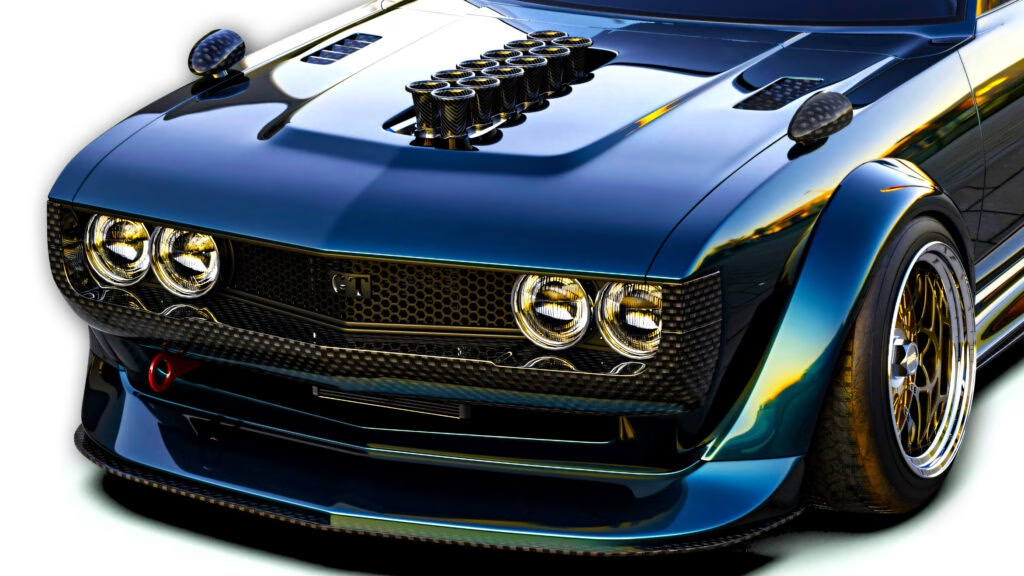How Did a Toyota Century V12 End Up in a Classic Celica?
You read that right—a V12 in a 1976 Toyota Celica. Not just any V12, but the legendary 5.0-liter 1GZ-FE from a Toyota Century limousine, an engine typically reserved for Japanese dignitaries and the occasional Yakuza boss. So how did this stately powerplant find its way into a compact, featherweight coupe from the disco era? Credit goes to Attacking The Clock Racing (ATC) and their lead builder, Shawn Bassett. Originally, Bassett dreamed of shoehorning in a Lexus LFA V10, but after hitting a brick wall sourcing one, he pivoted to the V12. The result? Pure magic.
What’s even wilder is that this isn’t just a stock engine swap. The V12 has been built up to a screaming 700 horsepower and can rev to a stratospheric 10,000 rpm—numbers that would make even seasoned tuners do a double take. Twelve individual velocity stacks, each with beautifully machined bells, poke through the hood like a mechanical bouquet. It’s the kind of detail that turns heads at any show, and it’s a testament to the level of craftsmanship poured into this build.
Why Would Anyone Put a V12 in a Celica?
Let’s be honest—because they can. But there’s more to it than just shock value. The original Celica was Toyota’s answer to the Ford Mustang, but with a smaller footprint and a four-cylinder under the hood. Fast-forward 55 years, and the Celica has become a cult classic, especially among JDM enthusiasts. Restomods and wild engine swaps are par for the course these days, but a V12? That’s a moonshot.
This build is about pushing boundaries and reimagining what a classic Japanese coupe can be. It’s also a nod to the creativity and technical prowess within the car community. According to SEMA’s 2023 report, custom builds and restomods have seen a 20% increase in popularity over the past five years, with engine swaps ranking among the top modifications for classic cars. The Celica V12 project is a perfect example of this trend taken to its logical—and slightly unhinged—extreme.
How Does the Transmission Work—And What’s With the Clutch Pedal?
Here’s where things get really interesting. The V12 is mated to a modern ZF8HP eight-speed automatic transmission, the same type found in everything from BMWs to the latest Toyota Supra. But unlike those cars, this Celica has a clutch pedal. Wait, what?
Bassett and his team engineered a way to manually control the ZF’s clutch packs using a traditional pedal. That means you can clutch-kick the car into a drift or rev the engine at a standstill—just like you would in a manual. When you’re done playing hooligan, you can drive it like a regular automatic. This hybrid approach delivers the best of both worlds: the engagement of a manual with the convenience (and speed) of a modern auto. It’s a clever solution that’s starting to pop up in high-end custom builds, but it’s still rare enough to make any gearhead do a double-take.
What Other Upgrades Set This Build Apart?
The V12 swap is the headline, but the supporting cast is just as impressive. The Celica rides on a custom air suspension with a pushrod rear setup, visible through the rear parcel shelf—a detail usually reserved for race cars. The wheels? Vintage BBS E55 racing rims, secured with custom center-lock hubs for that authentic motorsport vibe.
Inside, you’ll find a blend of old-school and modern: British Racing Green paint, tan leather, bespoke Speedhut gauges, and carbon-fiber bucket seats from Tillett Racing. The exposed and painted carbon components throughout the build add a contemporary edge without losing the car’s classic soul. This isn’t just a track toy or a show queen—it’s a rolling piece of art that balances performance, style, and heritage.
How Does This Build Compare to Other Restomods?
Restomodding has exploded in popularity, with builders blending vintage aesthetics with cutting-edge performance. Think Singer’s Porsche 911s or Icon’s Derelict series. What sets this Celica apart is the sheer audacity of its powertrain and the meticulous execution across every detail. It’s not just about going fast—it’s about doing so with personality and panache.
According to Hagerty’s 2024 market analysis, Japanese classics like the Celica are among the fastest-appreciating segments in the collector car world. Unique builds like this one don’t just turn heads; they set new benchmarks for what’s possible and often inspire a wave of copycats—or at least dreamers.
What’s the Real-World Impact of a Build Like This?
Beyond the wow factor, this Celica V12 project is a case study in what’s possible when passion meets engineering know-how. It challenges the notion that classic cars should be preserved in amber. Instead, it argues for evolution—taking the best of the past and fusing it with the innovations of today.
For the enthusiast community, builds like this spark conversation, fuel inspiration, and sometimes even controversy. Purists may grumble, but there’s no denying the technical achievement or the artistry involved. And for young builders or fans just getting into the scene, it’s proof that the only real limit is imagination (and maybe your budget).
What Can We Learn From This Wild Celica V12?
If there’s one lesson here, it’s that car culture thrives on reinvention. Whether you’re restoring a classic or dreaming up your own Frankenstein’s monster, the key is to make it yours. The big takeaway? Restomodding isn’t about perfection—it’s about smarter adjustments. Start with one change this week, and you’ll likely spot the difference by month’s end.

